Design of a small hallway: design nuances and interesting solutions

The first impression of a house or apartment is created by the entrance hall. Coming home, first you find yourself in it. The stylish and comfortable lobby invites guests and helps the hosts to receive them with dignity. Often small rooms do not provide an opportunity for even elementary courtesy gestures. There are design tricks that will make the compact space more comfortable.


Features of the room
A large entrance hall is not found in every home. A cramped room makes you want to increase the space, to make it as comfortable as possible. This can be achieved through design. What design is suitable for a narrow and square hallway?


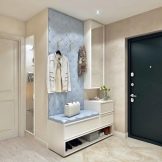
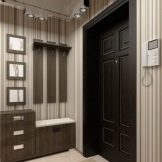
It is necessary to take into account the peculiarities of the premises and come up with a preliminary design of the hall.
The nuances of decorating a small hallway consist in observing several rules.
A minimum of furniture. Large wardrobes and large shoe boxes take up space and compel the room. Therefore, they choose open shelves, shallow dressers and pencil cases.


Wardrobes... All things from the hallway can be stowed away in one large wardrobe. The sliding door will not take up space when opened. Mirrors on the facade will help create the illusion of more space in a narrow hallway.


Engage corners. A corner wardrobe with shelves or a small wardrobe will fit well into the gap between the walls in a square hallway.



No dark range. It is not necessary to completely abandon dark tones. Skillfully combining them with light ones, you can get stylish solutions.
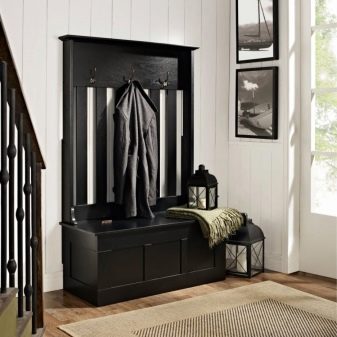

Designers recommend shades of the same color for decoration.
Mirrors. Mirrored surfaces visually increase area and illumination. A large mirror at the entrance to the apartment looks stylish and practical.


A minimum of details. Various little things in a small area immediately catch the eye and make the design eclectic. It is not recommended to overload small spaces with an abundance of decorative elements.


Style solutions
In terms of style, the hallway cannot differ from the interior of the house. Wall, ceiling and floor decoration, furniture and other items should be folded into a single whole. For a small room, minimalism is considered the most suitable style. In other areas, such as classic, provence, loft, it is better to focus on the basic principles of minimalism:
- open interior;
- multilevel lighting;
- lack of decor;
- two primary colors, the third is accent.



The functionality of each item is the main feature of minimalism. The main colors are white, milky, beige. Accents can be different, often - black, brown, gray. Strict and correct lines are preferred. Lighting plays a leading role. Diffused light makes a small space wider. Mirrors will help smooth out the imperfections of the room.



Hi-tech is a modern style that has incorporated elements of minimalism. Simple geometric lines are characteristic, furniture in the shade of the walls or lighter or darker by one or two tones with built-in lamps. Glossy surfaces in furniture finishing increase the volume of the room. Unusual lamps located on the walls, ceiling and floor create a light play.
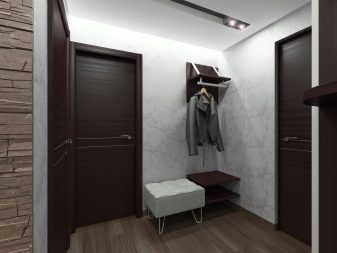
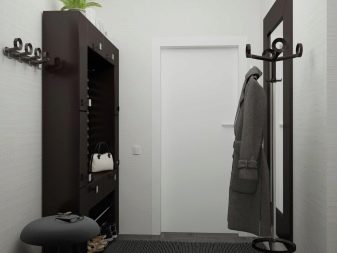

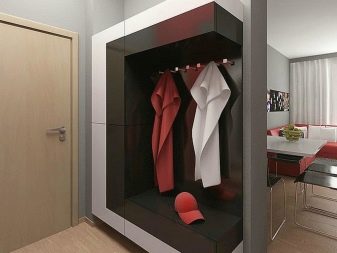
Metal, glass and plastic, or stylization for them, are most suitable for decorating a hallway in this style.
Provence is a romantic and delicate design dominated by pastel colors, light wooden furniture, floral and openwork decor. The emphasis is on the abundance of light and air. In a small area, it is important not to overdo it with decorative elements. Laminate or tiles are perfect for the floor, linoleum for parquet is a budget option. The walls are finished with plaster or wood paneling.



The motto of the loft style is nothing superfluous in the interior. The room is not divided into functional zones; they try to remove most of the furniture. The walls are finished with brick or masonry; plaster is often used. It assumes good lighting: lamps made in retro style are placed on the ceiling and walls, and floor options are also used. Solid colors and no carpets are encouraged.




The bright and spacious Scandinavian-style hallway looks modern and cozy. The most important thing in the interior is free space. Important components: tiles with striking patterns on the floor, painted or whitewashed walls, functional furniture made from natural materials or high-quality imitations (wood, textiles, leather)... The main color is white, combined with blue, light green, gray or black.



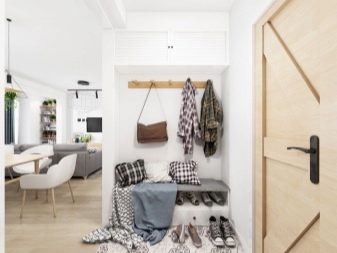
Accents of red, blue, orange are included with small splashes: a patterned rug or a bright pouf.
Real classics do not age and do not lose their relevance in modern times. Classic is a strict use of colors, shapes, compositions and a practical style. They choose natural materials or high-quality stylized ones. Preference is given to muted tones and natural colors. Compositional unity is created in the hallway space: they choose an interior item and build a common style around it.




Decorative elements in small spaces are removed or left to a minimum.
Selection of materials
For the hallway, finishing materials are chosen carefully, they should be:
- durable;
- water-repellent;
- durable.



The entrance hall separates the living quarters and the street - moisture and dirt, once in the house, remain in it. Regular cleaning, movement of different numbers of people lead to deterioration of the floor covering.
For the floor, it is better to choose:
- ceramic tiles;
- fake diamond;
- porcelain stoneware;
- linoleum;
- laminate.


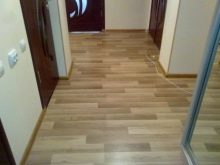
The above coatings have proven themselves well during operation. Linoleum and laminate are less resistant to mechanical damage than other types, but they are not inferior in terms of moisture and are not afraid of active detergents.
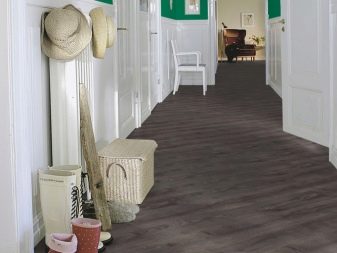

In hallways, a combination of ceramic tiles and laminate is often used: the threshold and the area near the front door are tiled as they are resistant to damage and easy to clean. The rest of the room is finished with laminate.
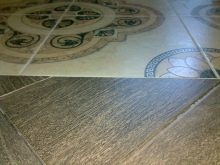


It is advised to trim the floor in narrow hallways with materials with diagonal patterns, it is believed that this makes the space wider. It is recommended to remove the thresholds between rooms and make a single-color floor covering.




For walls use:
- artificial stone (or imitation);
- brick-styled tiles;
- decorative plaster or ordinary;
- plastic panels;
- wallpaper;
- paint;
- cork covering.




Popular with modern designers in the decoration of hallways is stone, brick or decorative design for them. Materials are chosen in light or pastel shades, if the ornament is used, it is not bright, but muted, preference is given to medium-sized patterns or wide stripes.


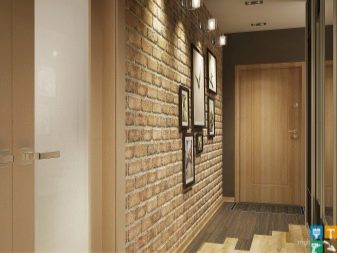

Accent and large drawings will visually fill the hallway, and narrow stripes will make it elongated.
The lower part of the room is made out a tone or two darker than the upper, so the effect of increasing the space is achieved. Now stores offer different options for combinations of wallpaper, combined in patterns and gamut. You can paste over opposite walls with different wallpaper, so you can stretch out a square room a little, and expand a narrow one.
You will have to take care of the walls in the hallway more often than in other rooms. Vinyl and non-woven wallpapers will come in handy: they hide defects well and are easy to clean. Liquid wallpaper gives a flat surface and is water resistant.

Walls painted with gloss for small hallways are perfect. Such surfaces reflect light, which means they increase the volume and enhance the illumination.
Originality will be added to the interior:
- combination of gloss and matte surfaces;
- combination of shades and textures;
- drawings and stencils.



Stylish and practical in the hallway will look decorative plaster. To apply it, it is not necessary to meticulously level the surface of the wall. Gives a decorative texture, can be easily washed from dirt.




A small space can be visually enlarged using special techniques. In a low hallway, it is chosen to decorate the ceiling white or any other light tone. Duplex plasterboard ceiling also increases the height of the room: outside there is a white frame, and in the middle there is a mirrored surface. For narrow and tall rooms, you can consider options with darker than the wall decoration, glossy ceilings.



Finishing options:
- whitewash;
- dye;
- wallpaper;
- PVC panels;
- dropped ceilings.


Color spectrum
The most harmonious will be a single color scheme for the floor, walls and ceiling. In a small hallway, this technique will help to visually increase the space. Using different shades of the palette of the same color, you can create interesting design options, diluting them with darker and lighter ones.


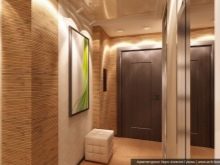
Choosing several colors for a small interior, 2–3 are preferred: one is taken as a basis, and the rest are used for contrasts to decorate individual areas.
Suitable as the main color:
- White;
- Gray;
- cream;
- pastel shades.




To create accents:
- Orange;
- blue;
- light green;
- metallic and other shades that will blend well with the base color.
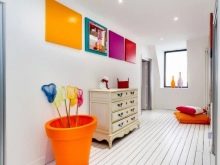
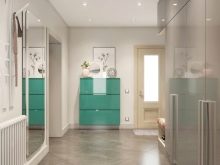

When choosing a color palette, it is important to take into account the features of the chosen style, the size and layout of the hallway. It is preferable to avoid large repetitive patterns and ornaments, plain surfaces are the best option for limited areas. If several doors go into the hallway, then their color should not differ from the color of the walls. Glazed doors or stained glass doors will also add light and space to the hallway.


Furniture selection
To save space in the hallway, preference is given to compact and multifunctional furniture:
- closet;
- a shoe box with a tabletop or ottoman on top;
- upper shelves for storing winter things;
- corner hallway.



It is recommended to give preference to small-sized furniture that will neatly fit into the interior in color, shape and size. Even the most stylish wardrobe will clutter up a small room and become annoyingly uncomfortable. Furniture that matches the color of the walls will create the impression of one common space.

The lower drawers can be made a tone or two darker, thus visually expanding the room.
Suitable for a small square hallway option of placing furniture on both sides. An open hanger with a shelf for shoes and a chest of drawers with a mirror is placed on one wall, on the other - a small wardrobe. Or corner cabinets with open or closed facades, and in the rest of the space they place shoe cabinets and an ottoman.

In a narrow hallway, it is not advised to put bulky cabinets with mirrors. The mirror is hung on the wall or the front door is mirrored. Shallow shoe boxes with special storage compartments are placed along the walls. There is a mezzanine above the door. A clothes hanger with hooks and a hanger bar is mounted on the wall.

A non-standard layout requires unusual solutions, furniture for such a hallway is chosen with great care, and sometimes it is made to order. The main thing is not to overload the area with unnecessary drawers and dressers, and if you choose a wardrobe, then it is small in size.


Of course, to furnish a small room, you need to consider different options, take measurements, choose furniture that matches the style and color of the interior. For storing outerwear, a wardrobe is considered the best choice: sliding doors do not take up space, and you can choose the required depth. You can equip a small area without large furniture: a mirror, a hanger with shelves and a shoe box are suitable for such an occasion.

Lighting
Most hallways have no windows, unless she is in a detached house. Lighting can highlight the pros and smooth out the disadvantages of a small space. A bright entrance hall in white colors seems more spacious, poorly lit - leaves an unpleasant impression.

There should be no difference in brightness between the hallway and other rooms. Lamps are matched with warm radiation, preferably all the same.
There are different lighting levels:
- top (ceiling lamps or chandelier);
- zoned (highlights functional areas: mirror, wardrobe, drawer for small things);
- decorative (for contour illumination of walls, ceilings, furniture, paintings and decorative elements).

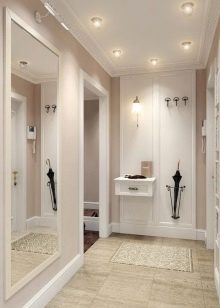
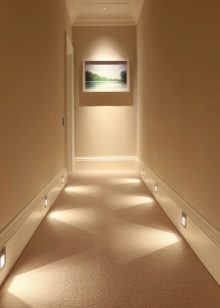
When choosing lighting methods, it must be borne in mind that the distribution and intensity of light can visually change the proportions of the hallway:
- lamps along the walls - lengthen;
- ceiling, lined up - will make it higher;
- located along the perimeter of the ceiling - will expand the space;
- bright light and reflective materials in the design of surfaces - will increase;
- transverse placement of light sources on the ceiling - shortens the room, and longitudinal - lengthens;
- reflectors on luminaires that direct the beams upward - raise the ceiling;
- ceiling lights aimed at walls - reduce their height.
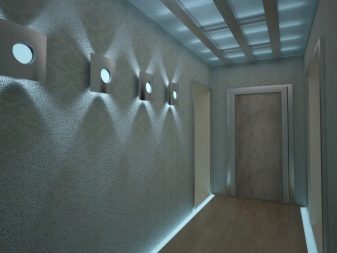

In modern design, a multi-level lighting system is often used. Multiple light sources are convenient and practical: to find clothes in the closet or look in the mirror, you do not need to turn on the bright overhead lamps.
Decorative elements
Wall decor for hallway
It is customary not to decorate the walls in a small hallway, but to do ordinary cosmetic repairs. Design experience suggests the opposite: drawing, painting can not only emphasize a certain style, but also make the room wider.
Photo wallpaper - the most popular way to increase a small area. Photographing a footpath, open window, or lawn view will give you a sense of spaciousness.

Paintings, bas-reliefs, elegantly embodied and integrated into the general style, create the same effect. Images can be done in any technique: fresco on plaster, mosaic, stained glass with lighting or a poster-poster in a baguette frame.

Mirrors
An important element of decor can be not only a mirror in an original frame or unusually designed, but also a mirror decorative panel on one of the walls. In such a room, the boundaries are pushed back beyond the mirror plane.

Plants
You can decorate even a small hallway with plant compositions, and not necessarily fresh indoor flowers. Living plants require regular lighting and maintenance, skillful imitation of indoor flowers is a great option if you don't have time to take care of your green friend.

Compositions of dried flowers and branches of intricate curves, artificial bonsai diversify the interior.
How to zone?
From the hallway, guests enter other rooms and a corridor, the arrangement of the latter requires effort and attention. There are different design options, one of them is zoning.
There are several reasons for separation in a small room:
- a long corridor merges with the hallway into a single space;
- the entrance hall is the place near the front door that gives the first impression of the house;
- the corridor and the hallway differ from each other in terms of functionality.

People enter the hallway from the street, clothes and shoes are left here, street dirt accumulates. A corridor is a gap between several rooms. Using simple techniques, they can easily distinguish between these two zones. This is done with:
- colors;
- furniture;
- lighting.

The walls and ceiling in the divided areas are trimmed with materials of various textures and shades, the floor is made in contrast, a partition or furniture is placed, rooms can be illuminated and decorated in different ways.
How to choose a design?
A small room causes certain difficulties for the owners with the placement of furniture, but completely abandoning individual items is a mistake. The hallway must be present: a hanger, a mirror and a rug. The mirror and hangers are placed on the wall, and the rug should be medium to large. If, in addition to these items, a narrow shelf for shoes fits, then you can pick up a model with a pouf.

Standard furniture is often an unsuitable choice for a small hallway in a "brezhnevka" and in a private house, and if you make it according to an individual project, it will be possible to more practically use the free space not only on the floor, but also on the walls.
For a small hallway in a one-room apartment, unnecessary decor elements are a design miscalculation. Bright colors and combinations, large patterns and designs fill the space no less than interior items. Mirrors placed on opposite walls multiply the congested interior by two more rooms. Minimalism and conservatism are taken as a basis in the design of a small hallway.

In the corridor and near the front door, it is recommended to hang furniture or put it on the floor in the baseboard so that dirt does not collect under it. Floor-to-ceiling built-in furniture is ideal.
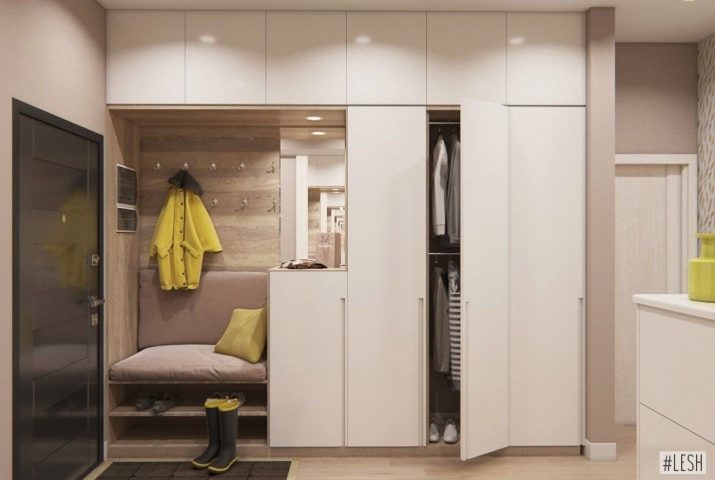
It is advised to make two switches: one - at the rug near the front door, and the other - to turn on the light from the apartment. So it will be possible to turn on the lighting without moving once again along the dirty floor of the hallway.
Light colors are preferred for walls and ceilings. Dark furniture and doors will also overwhelm a tiny room, so it's best to choose pastels or white.In narrow hallways and corridors, walls are finished with durable materials: decorative plaster, stone, slats are suitable. One wall is covered with one type of wallpaper or plaster, the floor is not overloaded with joints, and there should be several light sources.

Beautiful ideas
The small hallway is stylishly and practical.... It does not boggle the imagination of the visitor, but provides a place to take off your shoes and hang your clothes.

The classic hallway fulfills the requirements for the design of small rooms: a wardrobe, mirrors and a bench... Plain walls, diagonal floor tiles, white, two-level ceiling.

It is not uncommon in a private house - a non-standard hallway... Light colors, a tall cabinet against the wall, a bench in it or next to it. When choosing lighting, take into account that the window is an additional source of light.
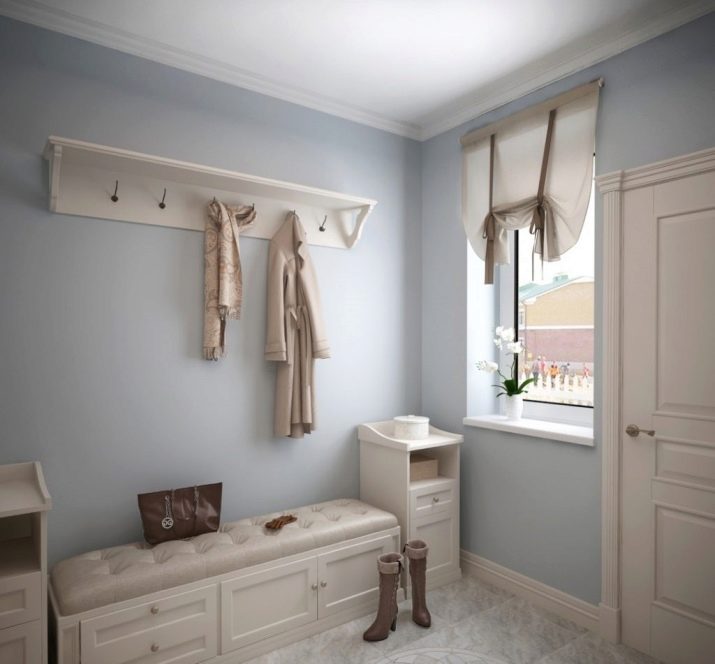
Various design options for hallways in private houses and vivid examples of design for a small apartment.


For design ideas for a small hallway, see the video below.








